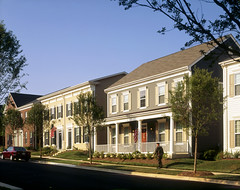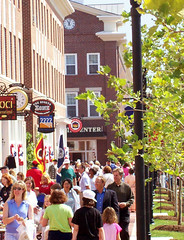Smart growth in uniform: Fort Belvoir's example

Posted July 15, 2008 at 8:59PM
We’ve had a long-running conversation within the LEED for Neighborhood Development committee as to whether or not civilian-style development on military bases should be eligible for certification under our system. It has taken me a while, but I’ve come around to believe that it should.
 Military bases are the ultimate “gated communities,” something LEED-ND does not and should not generally favor, and military installations are sometimes in remote locations not well connected to other parts of a region or to a region at all. They can also create a lot of environmental mischief.
Military bases are the ultimate “gated communities,” something LEED-ND does not and should not generally favor, and military installations are sometimes in remote locations not well connected to other parts of a region or to a region at all. They can also create a lot of environmental mischief.
But, if assisted with smart growth design principles, genuine neighborhoods can be created on military bases that function just like smart civilian neighborhoods, with walkable streets, compact design, and nearby conveniences. The result can not only reduce the need to drive on- or off-base for shopping and other community functions, reducing emissions; it can also create a welcoming, livable community environment for families who need and deserve all of that they can get.
Such an environment is just what architects Torti Gallas and developer Clark Pinnacle, in partnership with the US Army, are creating at Fort Belvoir in Virginia, south of Washington, DC. As a result of base consolidation, Fort Belvoir is scheduled to accommodate many more troops, functions and employees in the near future. This makes thoughtful planning especially important to both the environment and the quality of life for the base’s residents.
 Pictured at the top of this post and to the left is Herryford Village, which won a Charter Award from the Congress for the New Urbanism in 2006, and which has become the prototype for re-shaping family housing on Fort Belvoir. Clark Pinnacle’s press release summarizes its praiseworthy features:
Pictured at the top of this post and to the left is Herryford Village, which won a Charter Award from the Congress for the New Urbanism in 2006, and which has become the prototype for re-shaping family housing on Fort Belvoir. Clark Pinnacle’s press release summarizes its praiseworthy features:
“Characterized by pedestrian-friendly streetscapes and generous open spaces, Herryford Village exemplifies the principles of new urbanism. At a density of 7.5 units/acre, the 171-home neighborhood is respectful of the surrounding land and environment and brings the smart growth best practices of the private market place onto a military post.
“The partnership is the first on a military installation to develop several homes above retail, also known as “live/work” units. This housing, combined with a mix of retail uses below and an articulated streetscape design, are the first steps to creating a “Main Street” for the post. The Army was so impressed by the results and popularity of the homes that similar housing types are now being introduced on other Army posts across the country.”
Herryford is one of what will be 15 village-style clusters of colonial- and Georgian-style homes surrounded by green space and other amenities on the base. The partners’ work at Fort Belvoir also includes a town center with a Main Street atmosphere,  housing eleven neighborhood-friendly shops, including what is likely “one of the busiest barber shops in America,” according to the International Council of Shopping Centers, which also gave the project an award. The Town Center also houses a gym, two chapels, a child care center, and a library. Two dozen apartments sit above the shops, certainly a first for a military base, but they have proven popular and were rented within two weeks of becoming available.
housing eleven neighborhood-friendly shops, including what is likely “one of the busiest barber shops in America,” according to the International Council of Shopping Centers, which also gave the project an award. The Town Center also houses a gym, two chapels, a child care center, and a library. Two dozen apartments sit above the shops, certainly a first for a military base, but they have proven popular and were rented within two weeks of becoming available.
It seems so obvious: why shouldn’t the families of soldiers, sailors, and marines have great communities in which to live? Kudos to Torti Gallas, Clark Pinnacle, and the Army for having the vision to pull it off.
The goal is for the good work at Fort Belvoir to become a model for other military installations, and apparently a similar project is already under way at Fort Irwin in California. The Fort Belvoir project has also won awards from the National Association of Home Builders and the American Planning Association, and was the “Military Project of the Year” in 2007.